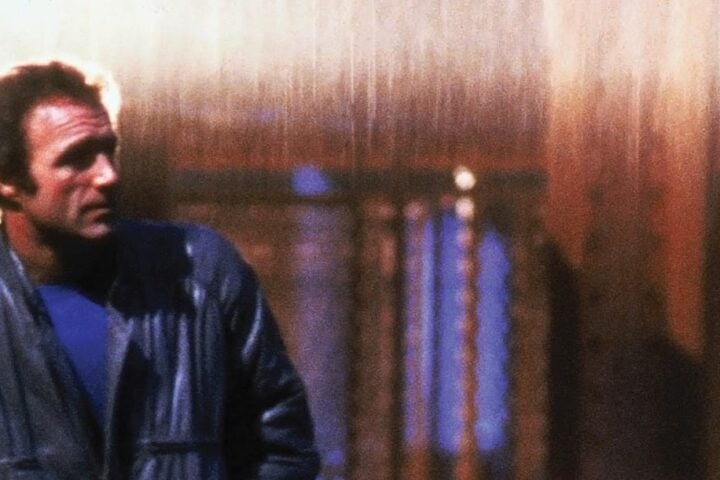Michael Mann’s strange and frequently beguiling Ferrari, which covers three eventful months in the life of Italian motor racing driver and entrepreneur Enzo Ferrari (Adam Driver), is a long-time passion project for its ever-idiosyncratic auteur. Mann wanted to make the film as far back as the early 2000s, when screenwriter Troy Kennedy Martin’s adaptation of a 1991 Ferrari biography by journalist Brock Yates was brought to his attention. It took a few false starts and several major cast changes, in addition to what a massive number of executive producer credits suggest is a transglobal patchwork of financiers. The result bears the scars of a long and rocky gestation, though not always to its detriment.
Reviewing Mann’s 1986 serial-killer thriller Manhunter, Chicago Reader critic Pat Brown described it as “simultaneously hypnotic and enervating, meditative and empty, like a white-noise background or a field of electronic snow.” That sense of concurrent being and non-being is key to the Mann aesthetic and ethos. Across his films, his characters assert themselves even as they remain oddly opaque, and the worlds that he conjures, though grounded in heavily factual research, often feel fantastical and tenuous, decidedly not of this earth.
Ferrari was shot primarily in Modena, Italy, where its lead character mainly resided, though verisimilitude is in no way on the menu. The film takes place in “1957” (the numbers appear on screen in an especially aggressive size and font) much as Mann’s gangster epic Public Enemies transpired in “1933.” We’re in a dynamic idea of the past that Mann approaches with strapping currency, which mirrors Ferrari’s single-minded stride through every waking second of his day.
Each moment counts from the minute Ferrari opens his eyes next to the woman, Lina Lardi (Shailene Woodley), who he loves and with whom he has a young son, Piero. But Lina isn’t his wife. That would be Laura (Penélope Cruz), his co-partner in business but no longer romantically. Their child, Dino, died in 1956 from Duchenne muscular dystrophy, a very rare genetic disease, so grief is still fresh, and the couple’s every interaction is prickly.
The first part of Mann’s film follows Ferrari as he attends to tasks ranging from the mundane (his daily shave) to the grief-stricken (a visit to Dino’s grave) to the tempestuous (a confrontation with Laura that culminates in a near-miss gunshot). Through it all, Ferrari does his best to maintain the steely look and demeanor that becomes many a Mann protagonist. An impeccably tailored suit is utilized like armor. All words spoken are terse and to the point. Emotion is never on display publicly, and only reluctantly in private.
It’s all a pose—but to the dual ends of endurance and survival, as Ferrari’s fortunes are waning. His namesake company is near bankruptcy, and the two lives that he leads, the one with Lina and the one with Laura, are on a collision course. So he turns his attention to the Mille Miglia, a dangerous 1,000-mile race across Italy in which a win by one of his cars could be a reputational boon. Those familiar with the history of that fateful competition (brilliantly orchestrated by Mann for the film’s lengthy climax) know that the outcome is a profoundly mixed one in which any triumphs are effectively nullified by tragedy. But it’s precisely that void, that liminal space between the peaks and the valleys of a person’s life, that Mann is most interested in exploring.
In one of Ferrari’s key scenes, all of the major characters attend an opera, and during an especially captivating duet, they think back to a moment from their past. It’s easy to imagine how most directors would handle this set piece—that is, with a florid emphasis on romanticism, the theatrical crashing melodramatically into the cinematic. Mann, though, works in a much different register, filming the two singers on stage in discomforting close-up and modifying the audio so that any echoing resonance (the kind you’d expect to hear in an opera house) is removed. It sounds instead as if the singers are directing their voices inward, toward an emotional center that proves, like the characters’ memories, fleeting and hollow, quick to vaporize in the arduous radiance of the present moment, from which there’s no respite.
Ferrari can only keep moving forward like one of his beloved vehicles, with its caterwauling combustion engine that he at one point rhapsodizes about to a captive Piero. Machines are easy to love, much more so than people, and Ferrari’s weaknesses in some ways stem from Mann’s inability to wrangle his performers as well as he does his tech. There was always going to be some risk in telling this very Italian story in English, though the worst-case scenario—the “That’s-a spicy meatball!” accents of Ridley Scott’s House of Gucci—is mostly averted.
Woodley isn’t done any favors by basically playing the supportive spouse role that Kim Griest flailed her way through in Manhunter, and she has the added disadvantage of Eye-talian-inflected speech patterns that she drops on a whim. Driver is often excellent, though more in the moments where physicality trumps feeling, his Ferrari working best as an insinuation of a person as opposed to an actual one. It’s Cruz who truly dominates, giving perhaps the best-ever female performance in a Mann film. Her Laura is a primal force of rage and regret who, in Ferrari’s sensational penultimate scene, battles her standoffish spouse to a smoldering detente. Their confrontation is the harrowingly human analog to the film’s virtuoso vehicular mayhem.
Since 2001, we've brought you uncompromising, candid takes on the world of film, music, television, video games, theater, and more. Independently owned and operated publications like Slant have been hit hard in recent years, but we’re committed to keeping our content free and accessible—meaning no paywalls or fees.
If you like what we do, please consider subscribing to our Patreon or making a donation.





